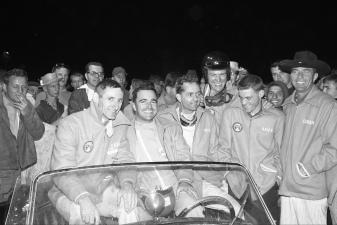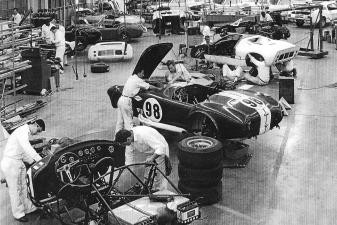Making History

Celebrate 60 years of iconic automotive designer and manufacturer Shelby American and watch the saga unfold from the men and women who lived it with the new book Shelby American: The Renegades Who Built the Cars, Won the Races, and Lived the Legend. The legendary shop didn’t last long, but it was a flame that burned incandescently before being extinguished by corporate politics. In less than a decade, it created a legacy that will be revered as long as cars still roar around racetracks. In this excerpt from the book, get a sneak peek at the start of the legendary company.
People rarely realize that they’re in the process of making history. They’re too busy making it. So the small cohort of men working in a cramped bay of a garage on the fringe of Los Angeles in February 1962 had no idea that the car they were assembling would sell at auction for $13.75 million five decades later or that the lanky, laid-back Texan overseeing the project would become one of the most enduring legends in automotive history. But there’s another reason—a much better reason—that they couldn’t imagine the glory to come. The way they looked at it, they weren’t working on anything unusual, much less monumental. They were simply doing what Southern California car guys had been doing for as long as any of them could remember:
They were building a hot rod.
Granted, this wasn’t a ’32 Model A with a flathead Ford. It was a two-seat roadster aimed at the sporty-car set instead of blue-collar gearheads. The chassis had been welded up by a small British company called AC Cars, based in the strange-sounding village of Thames Ditton. The aluminum bodywork had been hand formed into a barchetta shape popularized by the Ferrari 166 MM back in 1948. Nobody was going to confuse it with a Deuce Coupe or a lead sled or a road-racing special like the intimidating Scarab, which had been built a few miles away.
Still, the car was being put together in the well-known Santa Fe Springs hot-rod speed shop owned by Dean Moon, of Mooneyes fame. And while the engine wasn’t a flathead, it was a Ford V-8—a spanking-new 260-cubic-inch model designed to compete with the small-block Chevy. This particular motor had been thoroughly massaged by Mel Chastain, who would later be enshrined in the Dry Lakes Racing Hall of Fame. The headers had been fabricated by Fred Larsen, who eventually earned a slot in the Bonneville Salt Flats 300 MPH Club. Roy Gammell, Moon’s chief mechanic, was in charge of assembling the car. Among the people helping him was Dean Jeffries, soon to become a luminary on the SoCal custom-car scene.
Ironically, the man who’d commissioned the project was the one who understood the least about the nuts and bolts of the operation. Carroll Shelby was many things—son of a rural mail carrier in East Texas, World War II aviator, bankrupt chicken farmer, one-time concrete contractor, former exotic sports car dealer, and, most famously, Le Mans-winning race car driver—but he damn sure wasn’t a mechanic, much less a designer or an engineer. A few years earlier, while racing in a 1,000-kilometer race in Argentina, the engine of his Allard-Cadillac had caught fire. After peering under the hood and realizing he didn’t have the mechanical know-how to fix the flaming Caddy, he solved the problem by pissing on it.
Has the motorsports world ever produced a more colorful or complicated character than Carroll Shelby? Movie-star handsome and dangerously charismatic, he amassed a vast coterie of powerful friends and beautiful women, not counting his seven “official” wives. “Tall, skinny, wearing striped overalls, always with a pretty girl and always enjoying himself hugely, he was the very essence of what a race driver ought to be,” James T. Crow wrote in Road & Track. But race driver was only one of the many roles he played during his long and eventful life. More often, he was a serial entrepreneur with a cavalier attitude toward money—other people’s money, that is. Not for nothing did friends call him “Billie Sol,” alluding to the Texas con man who infamously faked mortgages on nonexistent agricultural ammonia tanks. As Don Frey once said about Shelby, “Whenever I walked out of his office after a meeting, I felt in my pockets to make sure everything was still there.”
Frey was joking, of course. Well, half joking. As the assistant general manager of Ford Division, Frey was the executive who’d signed off on the decision to give Shelby the engine he was now installing in the chassis from AC Cars even though he’d just met Shelby and didn’t really know anything about him. But this was par for the course. Closing deals with a raspy drawl and twinkling eyes, Shelby was a salesman for the ages and a bottomless repository of Texas tall tales that only occasionally intersected with the truth. “He could sell white blackbirds,” his first wife once said of him. But what he was really selling, most of the time, was himself.





